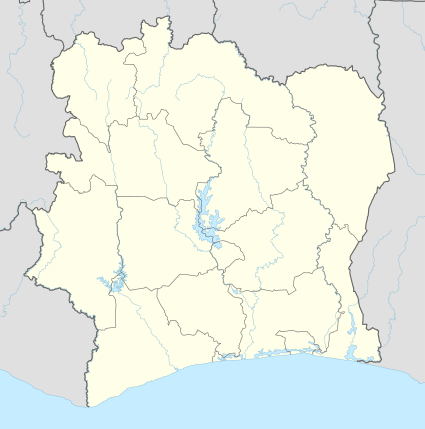Grand-Bassam
| Grand-Bassam | |
|---|---|
| Town, sub-prefecture, and commune | |
|
Colonial house in Grand-Bassam | |
 Grand-Bassam Location in Ivory Coast | |
| Coordinates: 5°12′N 3°44′W / 5.200°N 3.733°WCoordinates: 5°12′N 3°44′W / 5.200°N 3.733°W[1] | |
| Country |
|
| District | Comoé |
| Region | Sud-Comoé |
| Department | Grand-Bassam |
| Population (2014)[2] | |
| • Total | 84,028 |
| Time zone | GMT (UTC+0) |
| Official name | Historic Town of Grand-Bassam |
| Type | Cultural |
| Criteria | iii, iv |
| Designated | 2012 (36th session) |
| Reference no. | 1322 |
| Region | Africa |
Grand-Bassam is a town in south-eastern Ivory Coast, lying east of Abidjan. It was the French colonial capital city from 1893 to 1896, when the administration was transferred to Bingerville after a bout of yellow fever.[3] The town remained a key seaport until the growth of Abidjan from the 1930s.
Grand-Bassam is a sub-prefecture of and the seat of Grand-Bassam Department; it is also a commune. The town has the aura of a ghost town, since large sections have been abandoned for decades. In 1896, the French capital was moved to Bingerville, and commercial shipping gradually declined until it virtually ceased in the 1930s. In 1960, with independence, all remaining administrative offices were transferred to Abidjan, and for many years Grand-Bassam was inhabited only by squatters. Beginning in the late 1970s, the town began to revive as a tourist destination and craft centre.
The town is divided by the Ébrié Lagoon into two halves: Ancien Bassam is the former French settlement, facing the Gulf of Guinea. It is home to the grander colonial buildings, some of which have been restored. The district is also home to a cathedral and the Ivory Coast National Museum of Costume. Nouveau Bassam, linked to Ancien Bassam by a bridge, lies on the inland, northern side of the lagoon. It grew from the African servants' quarter and is now the main commercial centre of the town.
The town is the seat of the Roman Catholic Diocese of Grand-Bassam. The diocese's cathedral is the Cathédrale Sacré Cœur in Grand-Bassam.
In 2012, it was made a UNESCO World Heritage Site.
In March 2016, the town was targeted in a terrorist attack which killed at least 16 people.[4]
References
- ↑ "Ivory Coast Cities Longitude & Latitude". sphereinfo.com. Retrieved 19 November 2010.
- ↑ "Côte d'Ivoire". geohive.com. Retrieved 8 December 2015.
- ↑ http://whc.unesco.org/en/list/1322
- ↑ Tran, Mark; Duval Smith, Alex (13 March 2016). "'At Least 16 Dead' After Gunmen Open Fire in Ivory Coast Resort". The Guardian. Retrieved 13 March 2016.
External links
 Grand-Bassam travel guide from Wikivoyage
Grand-Bassam travel guide from Wikivoyage

